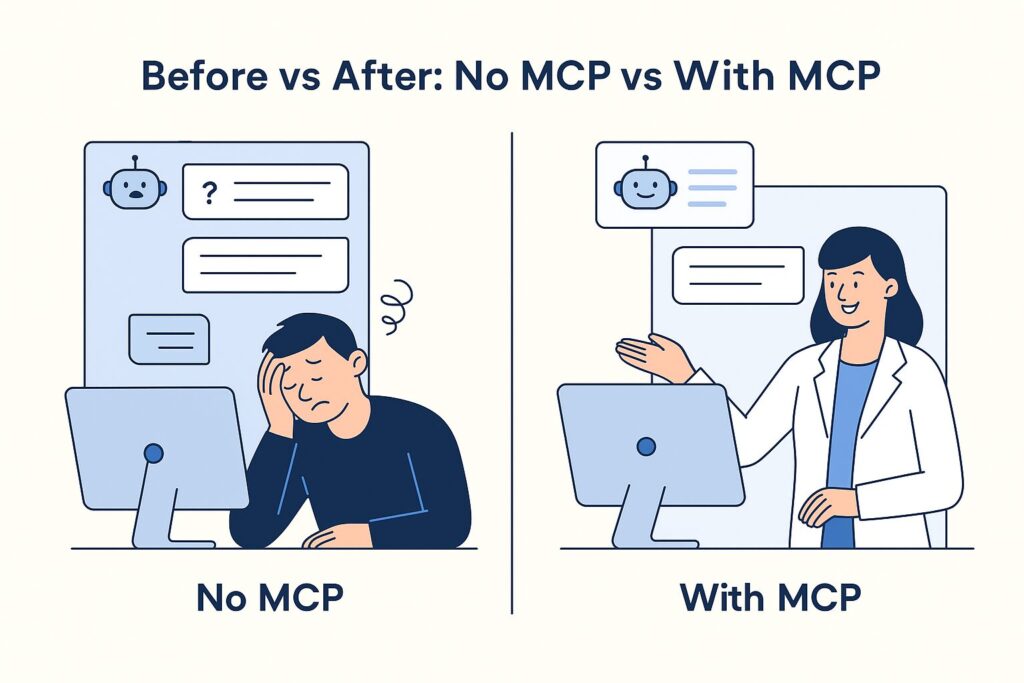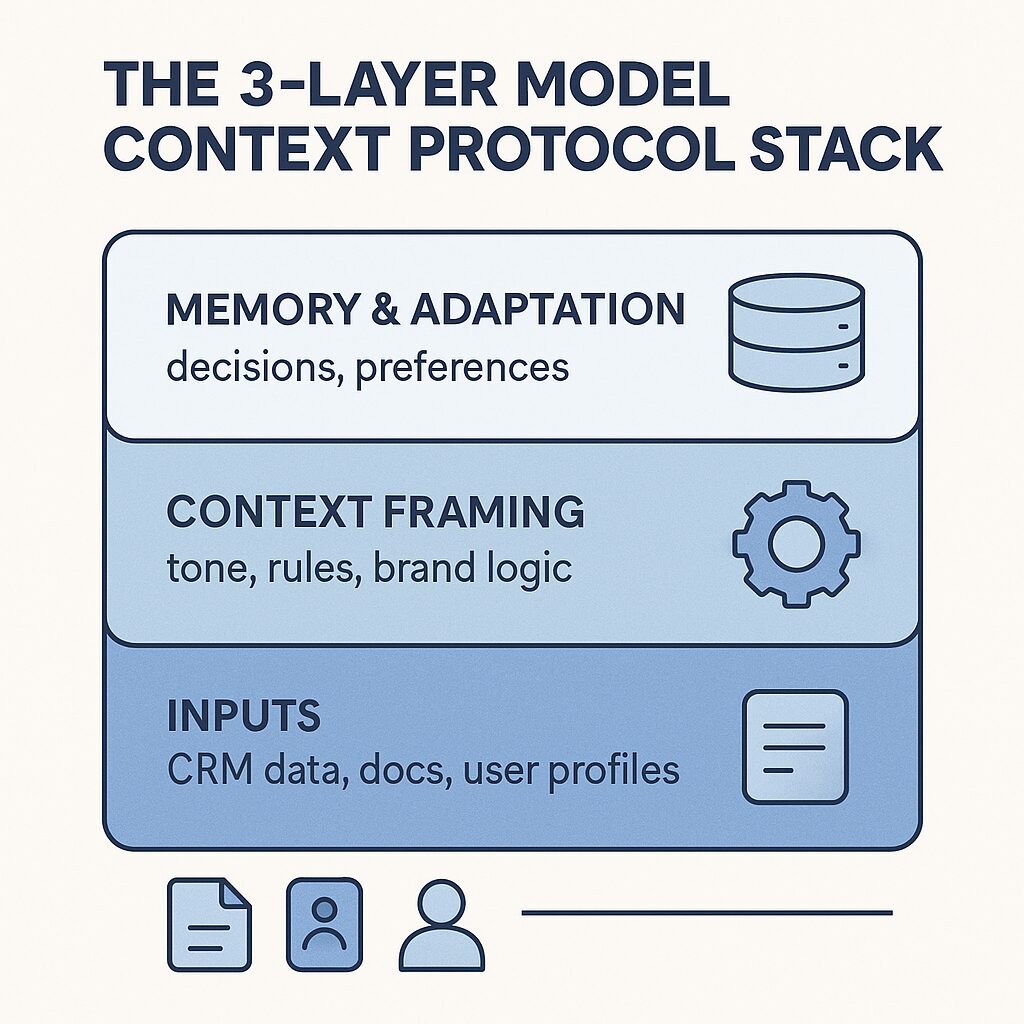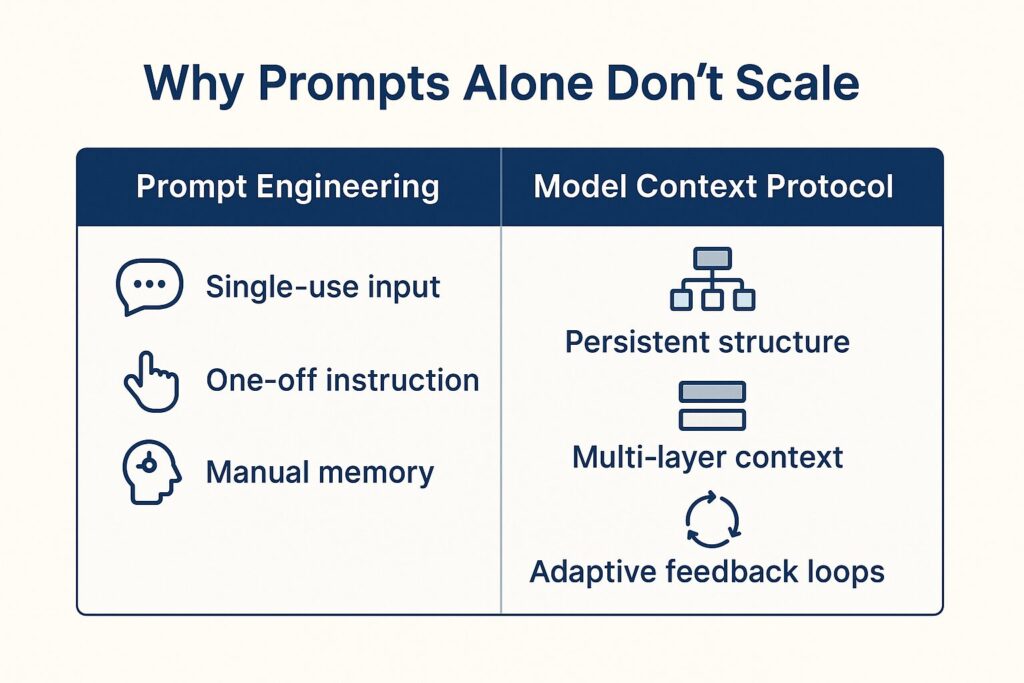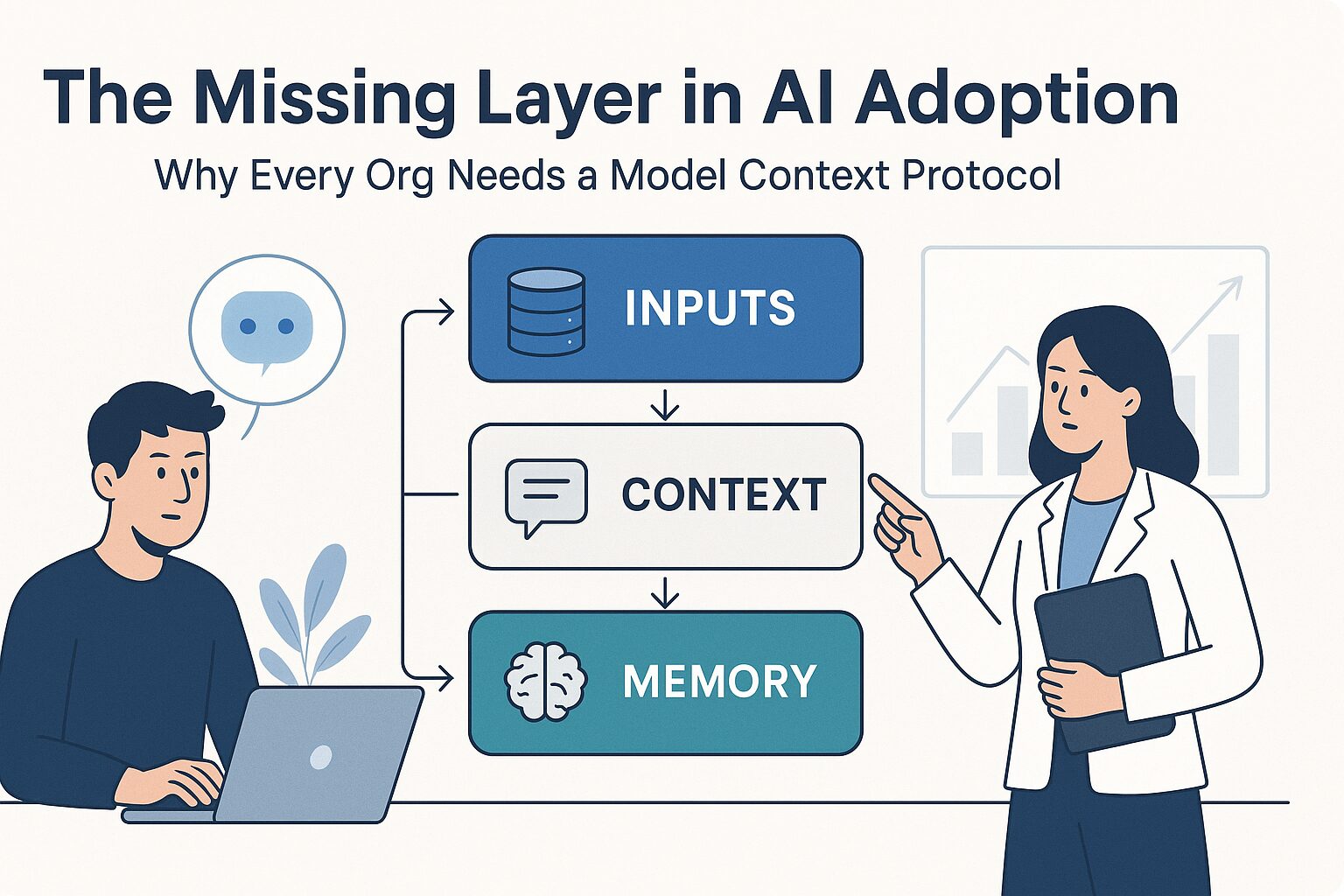Why AI Still Feels Dumb
You ask the same AI model the same question twice, and get two wildly different answers. That’s not intelligence; that’s poor context.
The numbers tell a sobering story: According to NTT DATA, between 70% and 85% of GenAI deployment efforts fail to meet their desired ROI, and the share of companies that scrapped the majority of their AI initiatives jumped from 17% in 2024 to 42% in 2025. These aren’t just statistics about underperforming tools.
They represent organizations that deployed AI across their teams, trained employees on prompt writing, and expected transformation. Instead, they got chaos. Sales teams with AI assistants quoting outdated pricing. Customer support bots that couldn’t handle edge cases. Content teams whose AI kept forgetting the brand voice between sessions.
The problem wasn’t the AI model. The problem was that each interaction started from scratch, with no structured way to carry forward knowledge, context, or organizational intelligence.

Model Context Protocol (MCP) is your internal API for AI, the protocol that makes it think like your team. Just as APIs revolutionized how systems communicate, MCPs are revolutionizing the way humans and AI systems share intelligence.
What Most Teams Get Wrong
Most organizations approaching AI adoption make the same fundamental mistake: they confuse data access with knowledge access. They dump documents into a vector database, write a few prompts, and wonder why their AI still gives inconsistent, shallow responses.
Here’s what typically goes wrong:
Over-reliance on natural language prompts. Teams think they can “ask ChatGPT” and get enterprise-grade results. However, without structured context protocols, you’re essentially conversing with someone who has amnesia and no institutional knowledge.
No memory architecture. Each AI interaction exists in isolation. The system learns nothing from previous conversations, decisions, or outcomes. It’s like hiring a consultant who forgets everything you told them the moment they leave the room.
At MyEListing, we identified an opportunity to enhance our AI support bot’s handling of complex edge cases. The model performed well on straightforward questions, but occasionally struggled when context spanned multiple systems or decision layers. By introducing a lightweight Model Context Protocol to guide responses and clarify escalation logic, we saw noticeable improvements in accuracy and resolution speed. The model didn’t change; the context did.
Context confusion occurs when organizations inundate their AI models with a wide range of data — including company documents, policies, chat histories, and real-time data — without a clear framework for prioritizing, structuring, or updating that information.
Take that sales enablement example. The bot accessed thousands of documents, but there was no protocol in place for handling conflicting information. When pricing changes, someone updates one document but not others. When a customer inquired about a complex enterprise deal structure, the AI was unable to synthesize the legal constraints, pricing tiers, and approval workflows because it lacked a structured way to understand how these components fit together.
Decoding the Model Context Protocol (MCP)

A Model Context Protocol is a structured system that governs how AI models receive, process, and apply knowledge within your organization. Think of it as the operating system for your AI’s intelligence.
An effective MCP addresses three core components:
Inputs
What knowledge the model receives: data sources, documents, user profiles, business rules, and real-time information. It’s not just about having access to information. It’s about curating the proper knowledge, ensuring it’s relevant to the context, and keeping it fresh.
Context Framing
Refers to how knowledge is structured and presented, including the roles, tone, constraints, and decision-making frameworks that shape the AI’s responses. It encompasses everything from brand voice guidelines to complex reasoning protocols.
Memory & Adaptation
What gets retained and evolved: conversation history, learned preferences, decision patterns, and feedback loops that help the system improve.
The key insight is that context isn’t just about what you tell the AI in a single prompt. It’s about building a persistent, evolving intelligence layer that grows smarter with each interaction.
Why MCP Is the New API Design
Twenty years ago, every software system was a silo. Then APIs created standard ways for systems to communicate, share data, and build on each other’s capabilities. APIs became the foundation of modern software architecture.
Model Context Protocols are doing the same thing for AI systems. They’re creating standardized ways for human and artificial intelligence to interface, share context, and build on each other’s reasoning.
Consider how the leading AI platforms already implement their versions of MCPs:
OpenAI’s system and user prompt structure separate the AI’s operational instructions from the user’s specific request. This simple protocol dramatically improves response quality and consistency.
Custom AI agents use role-based memory systems. A sales assistant maintains a different context than a legal document summarizer. Each has its own knowledge base, tone, and decision-making protocols.
Advanced memory systems, such as Claude’s project or ChatGPT’s long-term memory, maintain persistent context across conversations. They remember your preferences, past decisions, and ongoing projects.
The difference between these examples and what most organizations build is intentionality. Successful AI deployments don’t just accumulate context; they architect it.
Real-World Examples in Action
The most successful AI implementations I’ve seen all follow MCP principles, even when they don’t explicitly refer to them.
Enterprise AI platforms, such as Salesforce Einstein and HubSpot’s Breeze Copilot, succeed because they strategically layer context to enhance user experience. They are familiar with your CRM data, understand your sales process, and retain a record of your team’s preferences and decision-making patterns. When a sales rep asks about a deal, the AI doesn’t just search for relevant information: it applies the company’s specific qualification criteria, pricing logic, and approval workflows.
AI agent frameworks, such as LangChain, ReAct, and CrewAI, are essentially MCP implementations. They structure how agents receive information, make decisions, use tools, and remember outcomes. The agents work because they follow protocols for maintaining context across complex, multi-step workflows.
Custom AI implementations that scale all share common patterns. They define clear roles and responsibilities for their AI systems. They create structured knowledge hierarchies. They build feedback loops that improve context over time. They separate static organizational knowledge from dynamic user interactions.
The pattern is clear: successful AI adoption isn’t about finding the perfect model or writing the prompt. It’s about building the ideal context protocol.
How to Design Your MCP
Building an effective Model Context Protocol starts with understanding your specific use case and then creating structured layers of context that can evolve.
Start with Role Definition
What specific job is your AI system doing? A customer support bot requires a distinct context architecture compared to a financial analysis assistant. Define the role clearly, including goals, constraints, and success metrics.
Create Your Context Stack
Think of context as a layered cake, with each layer serving a specific purpose:
- Role & Goals Layer: The AI’s fundamental identity, objectives, and behavioral guidelines
- Knowledge Base Layer: Static organizational knowledge (policies, procedures, domain expertise)
- Tool Access Layer: What systems, data sources, and capabilities can the AI leverage
- Memory Layer: Dynamic information that persists and evolves (user preferences, conversation history, learned patterns)
- Output Style Layer: How the AI should communicate (tone, format, level of detail)
Design Your Input Format
Standardize the flow of information into your AI system by defining clear structures for user queries, system data, real-time feeds, and contextual triggers. The key is consistency. Your AI should always know what type of information it’s receiving and how to prioritize it.
Build Feedback Loops
Your MCP should improve over time. Your team can refine context by designing mechanisms to capture what works, what doesn’t, and how to improve over time. Examples include user ratings, outcome tracking, and automated quality assessments.
Plan for Evolution
Your organization’s knowledge and needs will change. Your MCP should have transparent processes for updating context layers, incorporating new information sources, and adapting to the evolving requirements.
The goal isn’t perfection from day one. It’s building a systematic approach to context that can scale and improve as your AI adoption matures.
The Strategic Advantage of MCP
Organizations that invest in structured Model Context Protocols gain several competitive advantages that compound over time.
Faster Time-to-Value
Instead of starting every AI interaction from scratch, teams can leverage accumulated organizational intelligence. New employees can access the same contextual depth as veterans. Complex decisions can build on previous reasoning rather than rehashing fundamental questions.
Consistency Across Teams
When different departments utilize AI systems, they receive responses that align with organizational standards and priorities. The sales team’s AI and the marketing team’s AI operate from the same foundational understanding of the business.
Reusable Intelligence.
Context developed for one use case can inform other use cases. Customer insights gathered by support AI can enhance sales AI. Product feedback analyzed by one system can inform strategic planning across the organization.
Protection Against AI Pitfalls
Structured context protocols reduce hallucinations, prevent confidential information leaks, and ensure AI responses align with company policies and values.
Perhaps most importantly, organizations with strong MCPs turn AI from a tool into a teammate. Instead of simply automating tasks, they’re augmenting organizational intelligence. They’re building systems that become smarter with each interaction, remember essential decisions, and help teams make better choices more quickly.
The companies that figure this out first will have a significant advantage. They’ll be where AI doesn’t just answer questions: it helps solve problems, supports decision-making, and accelerates human potential.
The question isn’t whether your organization needs AI. It’s whether you’re building the context protocols that will make that AI truly intelligent.
To make this more actionable, here are answers to some frequently asked questions about implementing a Model Context Protocol within your organization.
Model Context Protocol (MCP): Frequently Asked Questions
1. What is a Model Context Protocol (MCP)?
A Model Context Protocol is a structured framework that defines how AI models receive, process, and retain information. It governs the input format, context framing, memory handling, and output style. The goal is to move from isolated prompts to a scalable and reliable intelligence system.
2. Why does my AI assistant keep giving inconsistent answers?
Inconsistency is often a context issue, not a model flaw. Without a protocol for memory, tone, knowledge prioritization, and user history, the AI resets every time. It’s like hiring a new intern for each question.
3. Isn’t prompt engineering enough?
Prompt engineering helps, but it’s only part of the solution. It focuses on individual inputs rather than the overall system as a whole. The MCP structures context by building it, sharing it, and retaining it across roles, tools, and use cases.

4. How does MCP improve AI performance?
With an MCP in place, your AI can:
- Respond using a consistent brand tone
- Apply your organization’s decision-making logic
- Leverage previous conversations
- Handle edge cases more effectively
That shift turns your AI from a reactive tool into a proactive teammate.
5. How do I start building a Model Context Protocol?
Start with three core steps:
- Define the AI’s role and objective
- Create a “Context Stack” that includes goals, knowledge, tools, memory, and output style
- Build feedback loops to refine performance continuously
Begin with one high-impact use case and expand over time
6. What is the difference between MCP and API design?
APIs standardize how software systems communicate. MCPs standardize how humans and AI systems exchange intelligence. Both improve clarity and scalability, but MCP focuses on cognitive alignment rather than code.
7. Which platforms support context protocols today?
Many leading AI platforms already use MCP-like structures:
- ChatGPT includes system prompts and long-term memory
- Claude supports persistent project memory
- LangChain and CrewAI manage context for multi-agent workflows
- Salesforce Einstein and HubSpot ChatSpot use CRM-integrated context
Most organizations still need to formalize their internal MCPs to unlock full value.
AI adoption is just starting; the context layer will define who wins. I share lessons like this regularly on LinkedIn and StrategicAILeader.com – feel free to follow if you’re working through similar challenges.
Related Articles
The Ultimate Guide to Embedding-Based SEO Success
AI Agents Are Here: Unlock Growth, Speed & Scale in 2025
The Truth About AI-Driven SEO Most Pros Miss
Unlock Better MarTech with AI Marketing Automation
Win With AI: A Proven 5-Step Guide for Founders
Remarkable AI-Assisted Development Hack Slashed Dev Time
About the Author
I write about:
- AI + MarTech Automation
- AI Strategy
- COO Ops & Systems
- Growth Strategy (B2B & B2C)
- Infographic
- Leadership & Team Building
- My Case Studies
- Personal Journey
- Revenue Operations (RevOps)
- Sales Strategy
- SEO & Digital Marketing
- Strategic Thinking
📩 Want 1:1 strategic support?
🔗 Connect with me on LinkedIn
📬 Read my playbooks on Substack

Leave a Reply